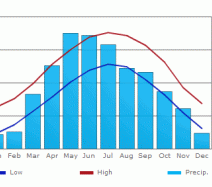In the grand theater of nature, altitude plays a leading role, intricately weaving itself into the narrative of climate. As one ascends into the heavens, the air grows thinner and the temperature shifts in ways that sculpt the environment below. Understanding how altitude impacts climate patterns reveals a layered story of ecological balance and atmospheric dynamics.
When one thinks about altitude, images of majestic mountains or elevated plateaus often come to mind. Yet, the implications of rising above sea level stretch far beyond mere aesthetics. The interaction between altitude and climate offers a fascinating lens through which we can examine weather phenomena, ecosystems, and even human activity.
Elevated terrains can transform a region into a microcosm of distinct weather variations, presenting a vivid tapestry of climatic conditions. From the verdant slopes of the Andes to the arid heights of the Tibetan Plateau, altitude acts as a powerful determinant of climate across the globe.
How Altitude Influences Temperature: A Cold Embrace
As one climbs higher into the atmosphere, a decrease in temperature is inevitable—a phenomenon governed by the environmental lapse rate. Generally, the air temperature drops by approximately 6.5 degrees Celsius for every kilometer ascended. This cooling effect can dramatically influence the types of vegetation and wildlife that thrive at various elevations. Mountain ranges like the Rockies or the Himalayas display unique ecological zones that shift with altitude, creating an extraordinary mosaic of life.
Consider the contrast between flora at low altitudes, luxuriant and tropical, compared to the rugged, wind-sculpted forms found in alpine zones. The lower regions bask in warmth and moisture, often characterized by dense forests. As one ascends, these lush environments gradually yield to increasingly harsh conditions. Each tier of elevation provides a unique climate that necessitates adaptation from the flora and fauna that occupy it.
Moreover, the temperature gradient becomes a critical element in setting the stage for climatic events. In mountainous regions, individual peaks can create rain shadows, leading to stark contrasts in precipitation on the windward and leeward sides. This can result in expansive deserts next to lush, green valleys, all dictated by the altitude at which weather systems interact with rugged terrains.
The Role of Altitude in Precipitation Patterns
Just as altitude changes temperature, it also profoundly affects precipitation patterns. Atmospheric pressure decreases with height, allowing air to rise and cool, which ultimately leads to condensation. This process, known as orographic lifting, is pivotal in regions where mountains serve as barriers to prevailing winds. As moisture-laden air ascends the mountains, it cools and precipitates, nurturing the ecosystems below with life-sustaining water.
In stark contrast, the leeward side often plunges into a drier, arid climate, devoid of the precipitation that nourishes the peaks. The phenomenon is strikingly evident in the Pacific Northwest of the United States, where the Cascade Mountains trap moisture and create lush rainforests, while the eastern foothills succumb to aridity. This intricate interplay of altitude and precipitation highlights the delicate balance maintained within climatic systems, where every inch gained in elevation can lead to vastly different weather patterns.
Moreover, higher altitudes can experience unique weather phenomena, such as rapid temperature fluctuations and intense storms. The thinner atmosphere and lower temperatures often lead to conditions where thunderstorms thrive, contributing to the dramatic shifts in weather that can be commonplace in elevated regions. Witnessing a thunderstorm roll through a mountain valley is striking—a fusion of power and beauty, a reminder of nature’s unbridled force.
Altitude’s Effect on Biodiversity and Human Activity
The diverse climates shaped by altitude profoundly impact biodiversity. High-altitude environments frequently harbor unique species, evolved to thrive in the ebbs and flows of their distinct climatic conditions. Endemic species in these ascendant realms often exhibit remarkable adaptations, displaying resilience where few can survive.
But altitude is not just a concern for the natural world; human activities are intricately intertwined with the climatic patterns dictated by elevation. Agricultural practices, for instance, must adapt to the unique challenges posed by altitude. While lower elevations may favor crops such as rice or corn, higher altitudes compel farmers to cultivate hardier species, such as potatoes or barley, that can withstand the cooler temperatures.
Moreover, altitude creates unique challenges for human settlement and health. Higher elevations can affect oxygen availability, impacting physical endurance and leading to conditions such as altitude sickness. Communities have adapted, developing cultures and lifestyles around these realities, illustrating the innate human capacity to endure and innovate.
In essence, the thread connecting altitude and climate patterns weaves together a complex tapestry rich with possibilities. While it shapes the intricate dance of temperature and precipitation, it also nurtures biodiversity and dictates human activity across various terrains. Understanding this relationship unveils the intricate dependencies sustaining ecosystems and communities alike, reminding us of the need to respect and protect our unique earthbound habitats.
As we gaze toward the heavens, let us appreciate the weight of altitude’s impact on the earth below. In this grand performance of nature, altitude is not merely a backdrop; it is a pivotal character—one that shapes the weather, molds ecosystems, and influences human existence. Embracing this understanding can inspire more conscientious stewardship of the diverse climates that exist within our world.








